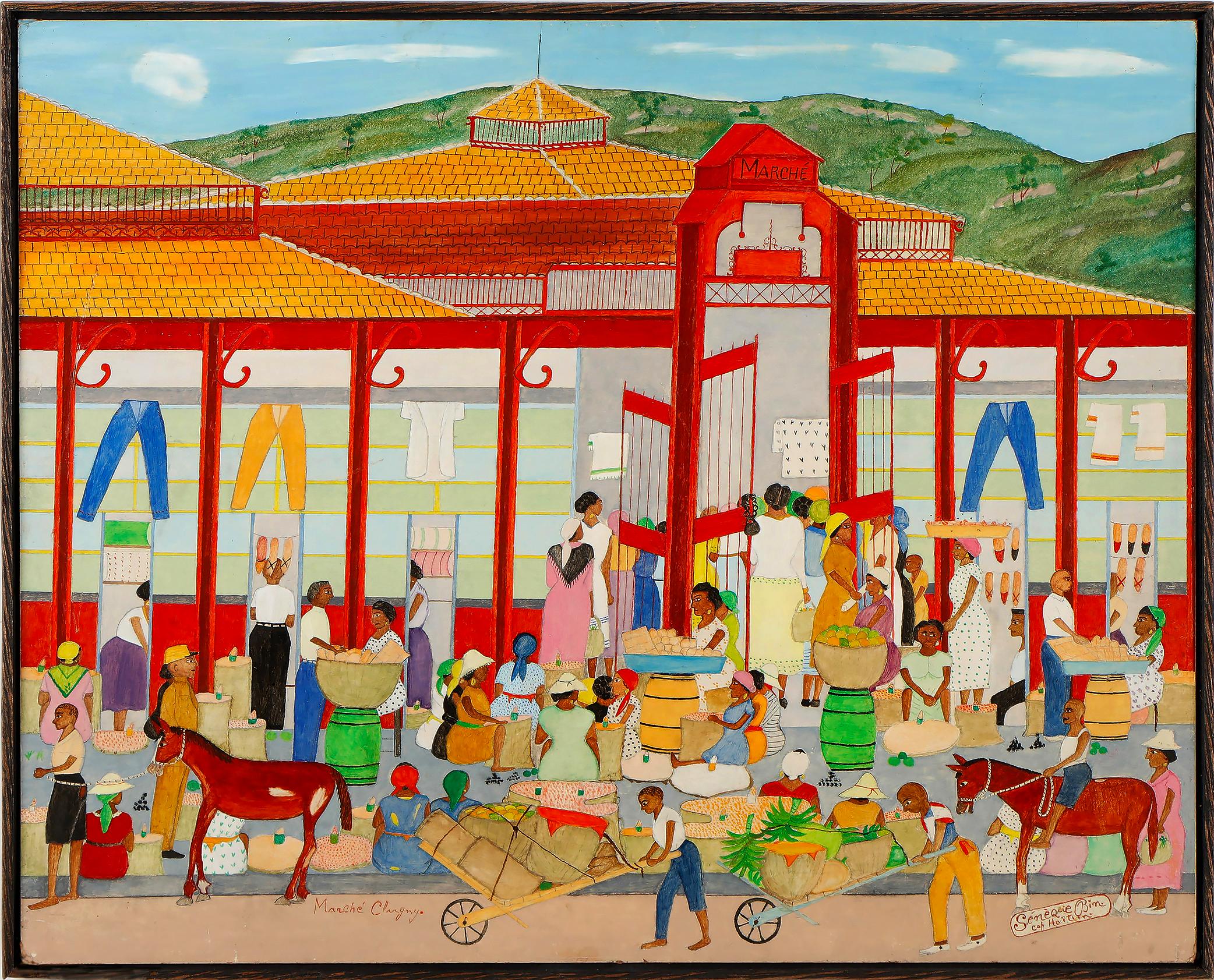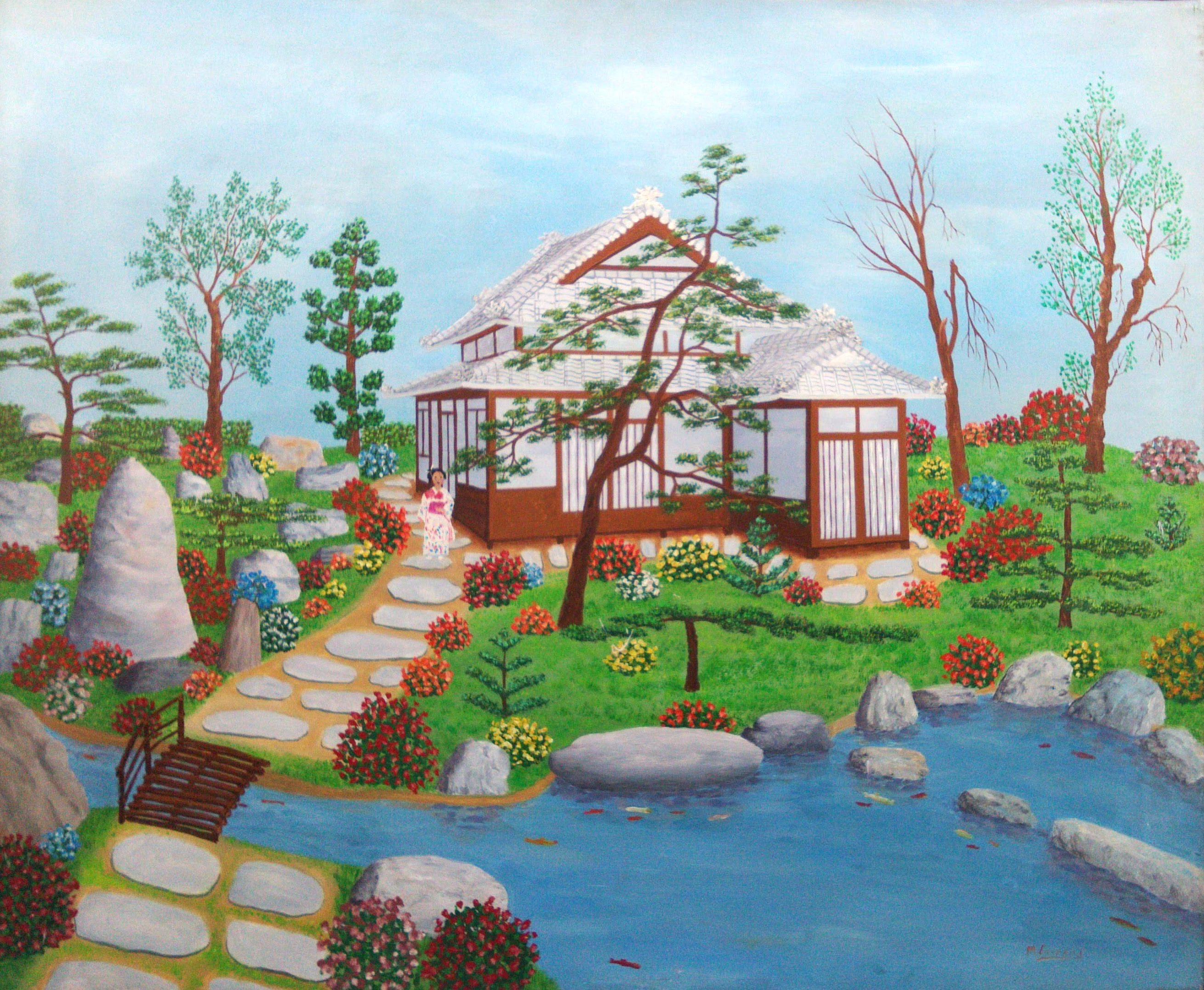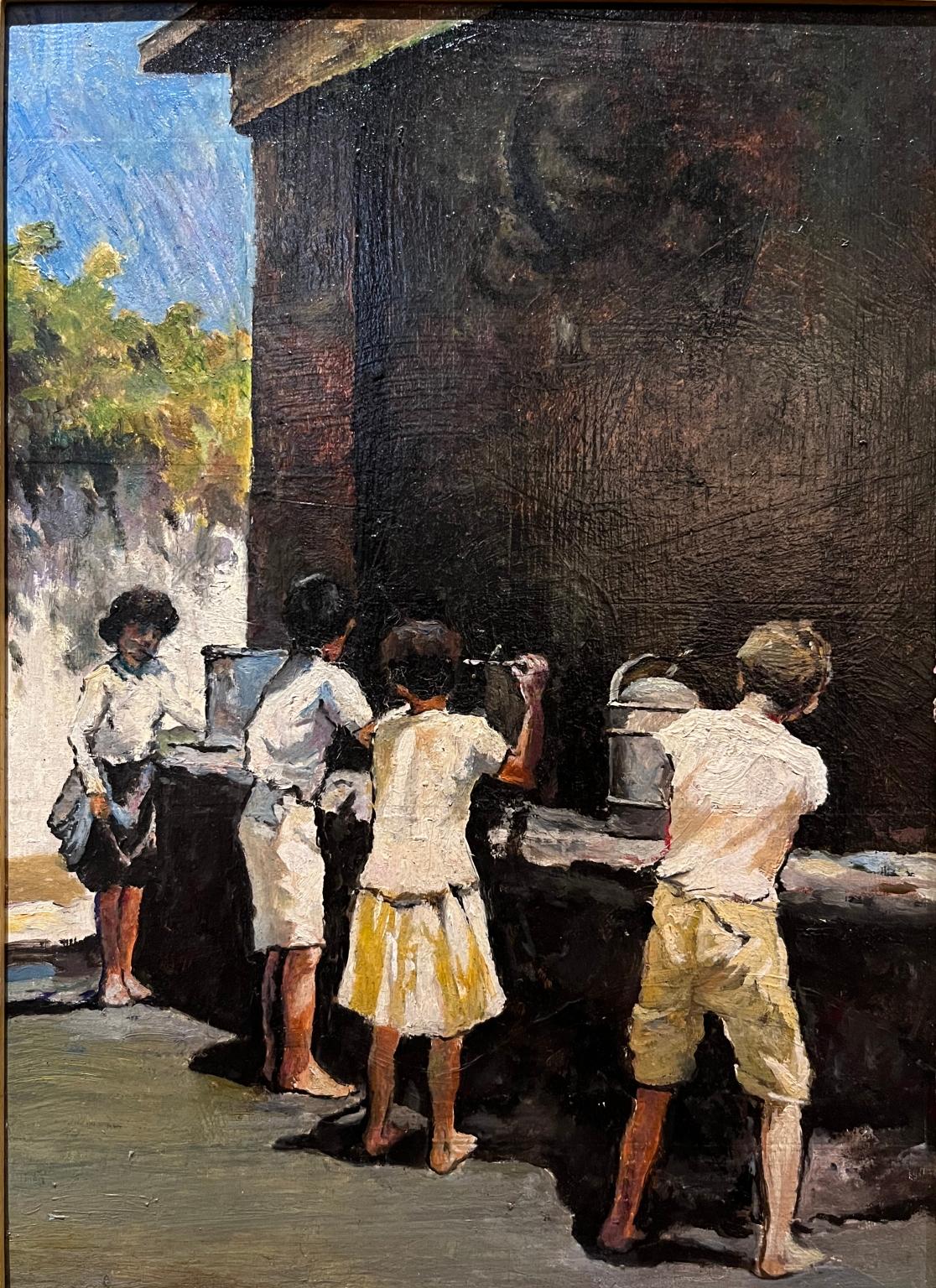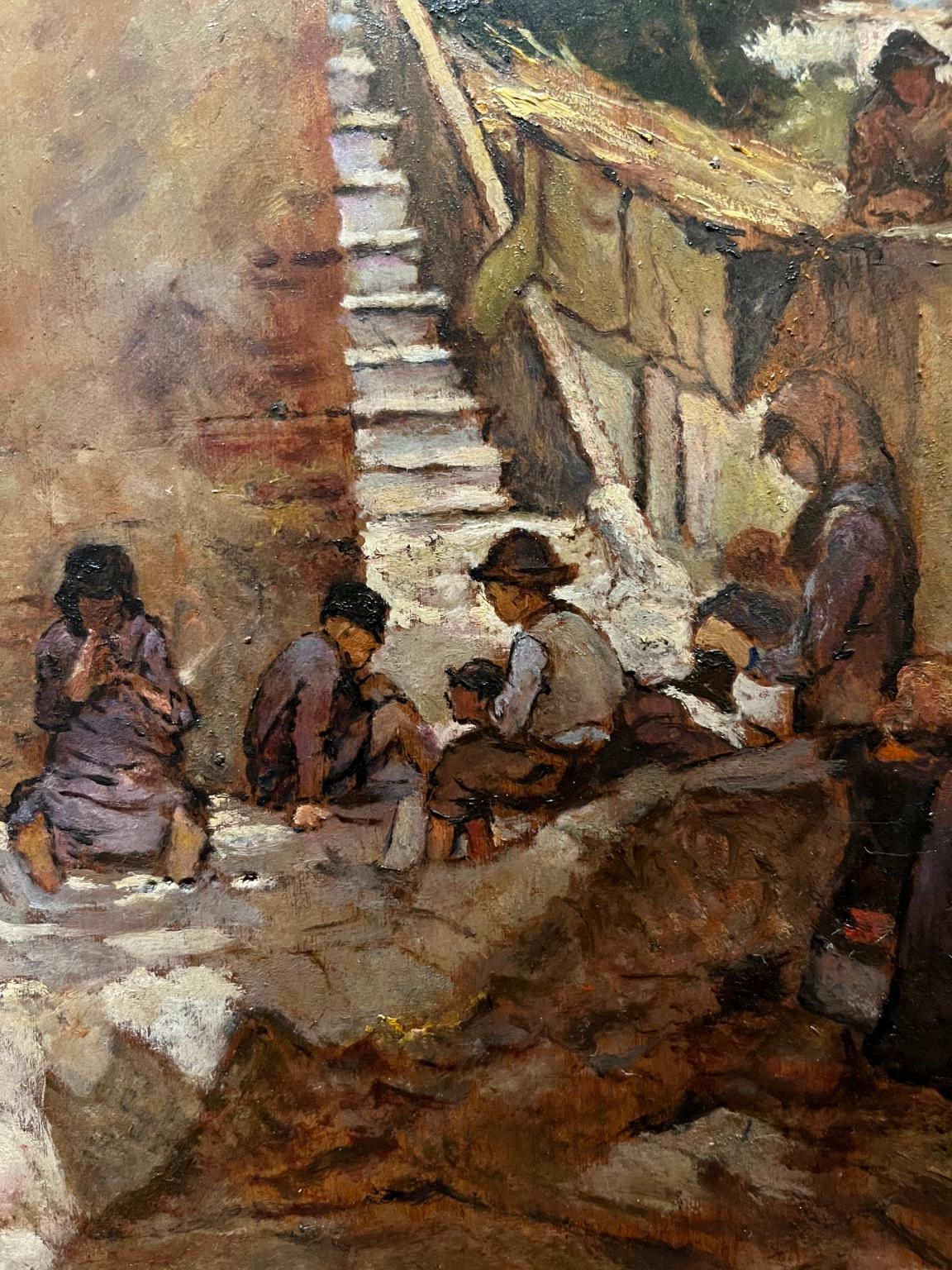Items Similar to "Swapping Horses" Fred E. Robertson, Grandma Moses, Self-Taught Landscape
Want more images or videos?
Request additional images or videos from the seller
Fred E. Robertson"Swapping Horses" Fred E. Robertson, Grandma Moses, Self-Taught Landscape1947
1947
About the Item
Fred E. Robertson (1878 - 1953)
Swapping Horses, 1947
Signed and dated lower right
Oil on masonite
12 5/8 x 24 inches
Fred Robertson, like his more famous older sister, Anna Mary Robertson (Grandma) Moses, was born on a farm northeast of Albany, New York, and grew up in relative poverty. While attending the district school, he earned extra money as a farmhand. Without the benefit of high school, he managed, at the age of twenty-three, to enter and ultimately graduate from Cornell Agricultural College. He taught school for a time, but in 1920 he bought a 300-acre farm in Savannah, New York, producing wheat, produce, and dairy products.
Around 1943, when his two sons began helping him work the farm, he had more free time and, encouraged by his sister, Robertson tried his hand at painting. This activity, taken up as a hobby, turned into a passion, and for the rest of his life Robertson devoted many hours to art. While he had picked up some technical tips from Anna Mary–using fairly dry oil paint on boards, rather than canvas–his style differed greatly from hers. His brushstrokes were stronger and bolder, his palette more somber, his subject matter less lyrical. In his landscapes, he documented life on the farm in a matter-of-fact manner, including numerous old-time vehicles and customs. In total, he completed about two hundred paintings.
Robertson had a one-man show at Galerie St. Etienne in 1945, which generated much interest and critical success. His works later appeared in group shows in New York and nationwide.
Roberta Smith reviewed the exhibition "The Forgotten Folk Art of the 1940's," at Galerie St. Etienne: "Still, it's great to see Israel Litwak's dense little landscapes in which careful patterns make every leaf and flower stand out. Also worthy of rediscovery are the paintings of Grandma Moses' younger brother, Fred Robertson, who took up the brush after his sister's success. Sibling rivalry is clearly as effective as any other artistic motivation: at least in this context, Robertson's less meticulous, more emotional landscapes and farm scenes outshine the efforts of his famous sister."
- Creator:Fred E. Robertson
- Creation Year:1947
- Dimensions:Height: 16.5 in (41.91 cm)Width: 27.5 in (69.85 cm)
- Medium:
- Movement & Style:
- Period:
- Condition:
- Gallery Location:New York, NY
- Reference Number:1stDibs: LU1841211235132
About the Seller
5.0
Platinum Seller
These expertly vetted sellers are 1stDibs' most experienced sellers and are rated highest by our customers.
Established in 2021
1stDibs seller since 2022
62 sales on 1stDibs
Typical response time: 1 hour
- ShippingRetrieving quote...Ships From: Larchmont, NY
- Return PolicyA return for this item may be initiated within 3 days of delivery.
More From This SellerView All
- "Neighborhood Shivaree, " Fred E. Robertson, Grandma Moses, Self-Taught LandscapeLocated in New York, NYFred E. Robertson (1878 - 1953) Neighborhood Shivaree, 1945 Signed and dated lower left Oil on masonite 16 x 20 inches Exhibited: Buffalo, The Buffalo Fine Arts Academy, Albright A...Category
1940s Folk Art Landscape Paintings
MaterialsMasonite, Oil
- "Young Beauty Crossing Brook with Hunter, " Emile Pierre Metzmacher French SalonLocated in New York, NYÉmile-Pierre Metzmacher (French, 1815 - 1890) A Young Beauty Crossing a Brook, A Hunter Beyond Oil on panel 24 x 19 1/2 inches Signed lower left Provenance: Christie's New York, Oct...Category
Mid-19th Century Figurative Paintings
MaterialsOil, Wood Panel
- "Bassin des Tuilleries and the Louvre, Paris, " Jules Herve, French ImpressionismBy Jules René HervéLocated in New York, NYJules Herve (French, 1887 - 1981) Bassin des Tuilleries and the Louvre, Paris, n.d. Oil on canvas 18 1/2 x 21 3/4 inches Signed lower left; signed on the reverse Provenance: Dominio...Category
20th Century Impressionist Landscape Paintings
MaterialsCanvas, Oil
- From the Grandstand - View of Racetrack and Crowd, Saratoga Springs, New YorkBy Anne DiggoryLocated in New York, NYAnne Diggory (b. 1951) From the Grandstand, Saratoga Springs Racecourse, New York Oil on panel 12 x 9 inches Anne Diggory lives in Saratoga Springs, NY, ...Category
1970s Contemporary Figurative Paintings
MaterialsBoard, Oil
- "A Man in His Garden, " Emil Carlsen, Backyard and Barn Impressionist LandscapeBy Emil CarlsenLocated in New York, NYSoren Emil Carlsen (1848 - 1932) A Man in His Garden, 1893 Oil on canvas 28 3/4 x 35 1/2 inches Signed and dated lower right Provenance: The artist [1848-1932] Macbeth Gallery, New ...Category
1890s American Impressionist Landscape Paintings
MaterialsCanvas, Oil
- "Day at the Beach, " Nikol Schattenstein, Sunny Seaside Belgian Figurative SceneBy Nikol SchattensteinLocated in New York, NYNikol Schattenstein (1877 - 1954) Day at the Beach Oil on canvas 27 3/4 x 33 1/2 inches Signed lower left Provenance: Descended in the family of the artist Estate of Howard Aronso...Category
Early 20th Century Impressionist Landscape Paintings
MaterialsCanvas, Oil
You May Also Like
- "Cars, Buildings People" Contemporary Outsider Folk Art African American UrbanBy Purvis YoungLocated in New York, NY"Cars, Buildings People" Contemporary Outsider Folk Art African American Urban The painting measures 65 x 48 inches. We love that in the middle of ...Category
1990s Outsider Art Landscape Paintings
MaterialsMasonite, Oil
- Marché Cluny - Market at Cap-Haitien - Haitian Street ArtLocated in Miami, FLA bustling street scene of everyday life in front of the famed Marché in Cap-Haïtien is rendered in Sénèque This is a relatively early work by Obin's signature brightly colored and flat naive style. Signed lower right. Provenance: Galerie Issa - Port-Au-Prince, Haiti - Owned by Issa El Saieh of later named El Saieh Gallery Sénèque Obin...Category
1950s Outsider Art Landscape Paintings
MaterialsOil, Masonite
- Japan Japanese Garden by French naive outsider folk art primitive artist, 1975Located in Norwich, GBA perfect painting for lovers of Japan and those of primitive/naive outside art. It is a work by an internatoanlly noted extraordinary artist with an extraordinary life. Maurice LOIRAND (1922-2008) is born into a working class family in Brittany, near the Atlantic coast coast in France. He starts working as a skilled labourer in the shipyards aged 15. Aged 20, when the Nazis start to occupy the country, he joins the Resistance movement, where he meets and befriends thinkers, painters and poets. He is thus introduced to an artistic and intellectual universe far removed from the world of his origins. Loirand finds himself drawn to art, and soon dedicates all his free time to learn how to paint. Completely self taught, he soon begins to exhibit his pictures alongside high level artists. He moves to Paris in the 1950s, and - although still working as a technician - paints all night. He finally becomes a full time artist in 1968. International travel and a multitude of exhibitions follow. He exhibits in Brazil, Argentina, and with Jean Tiroche Gallery in New York, among others. His work is now shown alongside works by Leger, Matisse and Picasso. The Collector's Guild New York Ltd commissions Maurice Loirand for several works of lithographic art. Loirand discovers Japan in the early 1970s, and decides to stay for 18 years. He marries Kazué SHIMOTORI, a Japanese poet...Category
1970s Outsider Art Figurative Paintings
MaterialsOil, Canvas
- Tuscan Figurative Genre Scene painting 20th century oil on canvasLocated in Florence, ITThe artist of this painting is unknown but it can be ascribe to a Tuscan movement of the 20th century inspired by 19th century art like Verismo (as we can deduce by the clean and not...Category
20th Century Folk Art Figurative Paintings
MaterialsCanvas, Oil
- Tuscan Figurative Genre Scene painting 20th century oil on canvasLocated in Florence, ITThe artist of this painting is unknown but it can be ascribe to a Tuscan movement of the 20th century inspired by 19th century art like Verismo (as we can deduce by the clean and not...Category
20th Century Folk Art Figurative Paintings
MaterialsCanvas, Oil
- French Folk Art Naive Oil Painting Workers in Vineyard, Les Vignes aux GitansLocated in Surfside, FLMax Savy Oil on canvas painting depicting a village scene with winemakers in a vineyard by artist Max Savy (French, b. 1918). Signed in the lower right. Frame measures 24.5 inches x 28 inches. canvas is 18 X 22 inches., Perfect for a wine cellar or cave. Max Savy (French, 1918-2010) painted scenes of everyday life in the French Corbieres region, which garnered much success during his life. Though the artist remained silent about his early life, it's known his father instilled in him a belief in the humanist socialism philosophy of French Socialist Party leader, Jean Jaures. In 1938, at age 20, he moved to Carcassonne to attend school. There, he married and settled into a teaching position, joining the French Resistance during World War II and earning the Cross of the Combatant. After the war, he created the work for which he is most admired. Max Savy paintings are part of France's heritage collection, and the artist became a knight of the National Order of Merit in 1973. Max Savy's paintings and artworks include scenes of peasants in the fields. Max Savy was active/lived in France. Max Savy is known for folk art style painting of village architecture, vintners, figures in landscape, wine makers, marine scenes. His work is similar in style to the naive, folk art paintings of Michel Delacroix and Fanch Ledan. This is quite similar to a work I had titled "Les Vignes Aux Gitans" (the gypsy grape vines) So i assume this is also a vineyard painting...Category
Mid-20th Century Folk Art Landscape Paintings
MaterialsCanvas, Oil
Recently Viewed
View AllMore Ways To Browse
Horse Landscape
Horses In Landscape Art
Painting Of A Horse In Landscape
Landscape Horses Oil
Brother Sister
Agriculture Art
Three Sisters
Little Brothers
Three Sisters Art
Horse Painting Old
Israel Landscape Painting
Israeli Landscape Paintings
Life Of Fred Used
Old Money
Motivational Art
Man And Horse Painting
Old Money Style
Mary Manning




